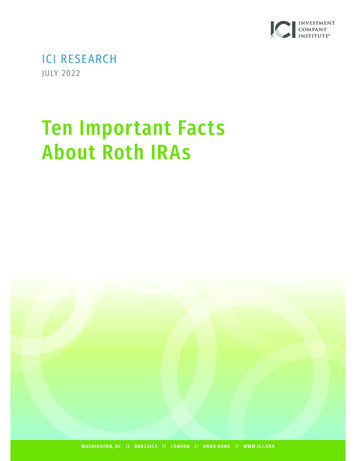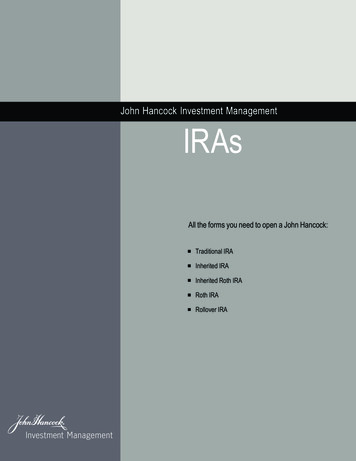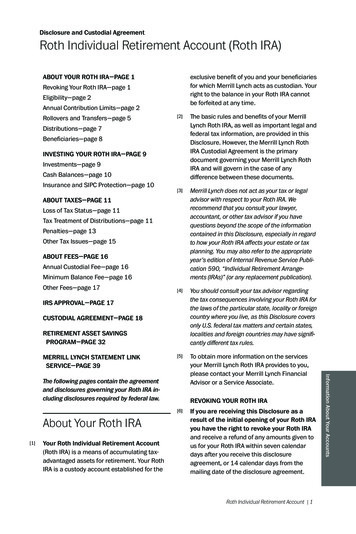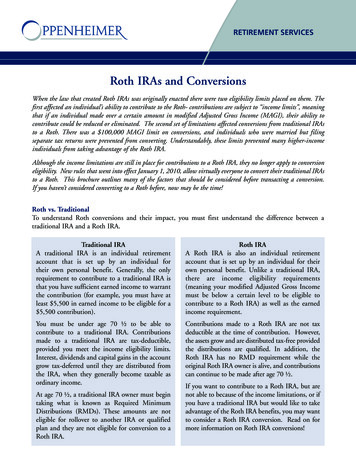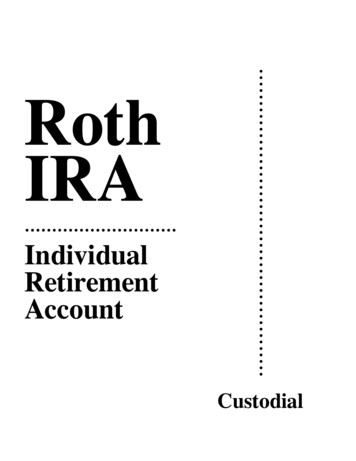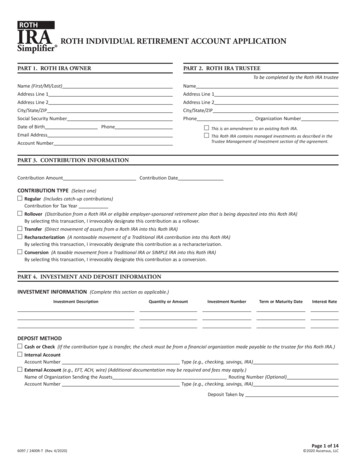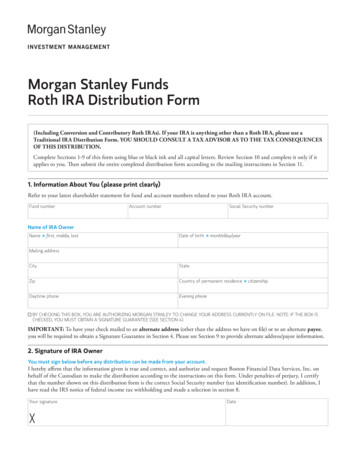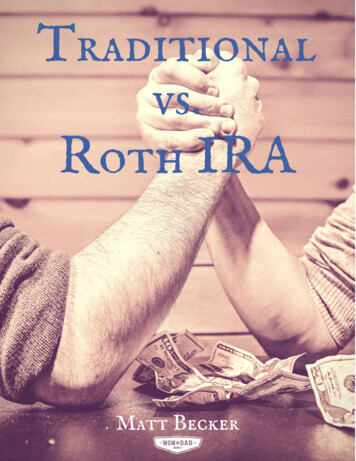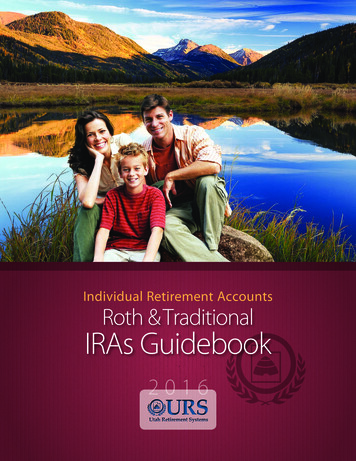
Transcription
Individual Retirement AccountsRoth & TraditionalIRAs Guidebook2016
IRARoth & TraditionalIndividual Retirement AccountsAt-a-GlanceEligibilityContentsIRAs At-a-Glance. 1Roth IRA. 2Traditional IRA. 3Roth andTraditional IRAContribution Limits. 5A Roth IRA allows non-deductible (after-tax)You may contribute as long as you have earned income(regardless of age).You may contribute if you are under age 70½ and have earned income. A single income tax filer with income up to:No income limits.Rollover/TransfersYou may roll over or transfer money into a Roth IRA from: Roth IRA 457(b) 403(b) Roth 401(k) 401(a) Qualified Pension (onlya lump-sum distribution) Roth 403(b) 401(k)(See page 6 for details.)You may roll over or transfer 401(k) Traditional IRAmoney into a traditional 401(a) 403(b)IRA from the following: 457(b) Pension (only a lumpsum distribution)Convert IRAYou may convert all or part of your traditional IRA to your Roth IRA.You may convert all or part of a traditional IRA to a Roth IRA.Amounts converted from a traditional IRA to a Roth IRA aresubject to income taxes, but are not subject to the 10% earlywithdrawal penalty tax.Amounts converted from a traditional IRA to a Roth IRA aresubject to income taxes, but are not subject to the 10% earlywithdrawal penalty tax.Key Tax AdvantageFederal tax-free growth (earnings may also be free of state income taxes).Tax-deferred growth.Tax-DeductibleContributionsContributions to a Roth IRA are not deductible from your incomefor tax filing purposes.The deductibility of contributions is subject to modified adjusted grossincome (MAGI) limits and participation in an employer-sponsoredretirement plan. (See page 3 for MAGI limits.)etc.), provide additional options to save forestate planning.Members of Utah Retirement Systems are eligible to participate.Contributionsare subject toincome limits.If you are:(IRAs) combined with other retirement plansretirement and may assist you in your tax andMembers of Utah Retirement Systems are eligible to participate.Contribution limits are the same for both the Roth IRA and traditional IRA. Contributions to all IRAs must be combined towardthe total limit. For example, if you contribute 1,000 to a traditional IRA at your bank and another 1,000 to your URSTraditional IRA (total of 2,000), you may only contribute up to 3,500 to your Roth IRA (for a total of 5,500 in 2016).traditional IRA. Individual retirement accounts(e.g., 401(k), 457, pension, Social Security,Traditional IRAMaximum AnnualContribution(This is the totalamount for all IRAsyou may have.)Utah Retirement Systems (URS)administers a Roth IRA and aRoth IRAThe maximum annual contribution limit is 5,500 for 2016.For those ages 50 and older an additional “catch-up” contribution of 1,000 may also be made, bringing the total to 6,500 in 2016. 117,000 — qualifies for a full contribution 117,000 to 132,000 — qualifies for a partial contributionover 132,000 — cannot contribute A married/joint income tax filer, with income up to 184,000 — qualifies for a full contribution 184,000 to 194,000 — qualifies for a partial contributionover 194,000 — cannot contributeTransfersand Rollovers. 6contributions. This gives you the advantage ofWithdrawal EligibilityA withdrawal may be made at any time.A withdrawal may be made at any time.Conversions. 7tax-free withdrawals when certain conditionsTax Treatmentof WithdrawalsAll earnings and deductible contributions may be subject to incometaxes when withdrawn.Investing Your Funds. 8are met.Contributions can be withdrawn, at any time, without taxes or penalties.Earnings can be withdrawn without taxes or penalties if you are over age59½ and you have had a Roth IRA for at least five years.10% Early WithdrawalPenalty TaxIf you are under age 59½ you may avoid the penalty tax if yourwithdrawal is for one of the following reasons: First-time home buyer Qualified higher education expenses Payments paid to you based on your life expectancy Health insurance premium payments when unemployed Payments of medical expenses in excess of 10% of youradjusted gross income Disability or deathIf you are under age 59½, you may avoid the penalty tax if yourwithdrawal is for one of the following reasons: First-time home buyer Qualified higher education expenses Payments paid to you based on your life expectancy Health insurance premium payments when unemployed Payments of medical expenses in excess of 10% of youradjusted gross income Disability or deathRequired WithdrawalsThere are no required (or minimum) distributions while you are living.Required minimum distributions must begin after you reach age 70½.Other Thingsto Consider.10URS Savings PlansComparison Chart.11Glossary ofInvestment andFinancial Terms.12A traditional IRA may allow you to deductall or part of your contributions for incometax purposes, while deferring any taxes oninvestment earnings until you start makingwithdrawals.1
URS Roth & Traditional IRAsURS Roth & Traditional IRAsRoth IRAXThings to Know PenaltiesAs with a traditional IRA,you may be subject to apenalty tax if you withdrawyour earnings before youreach age 59½ or if youcontribute more than either100% of your earned incomeor the allowable maximumfor a year.Benefits of a Roth IRATax Deferral ofInvestment EarningsInvestment earnings compoundtax free. This allows your IRA to growfaster than if it were subject to annualtaxation. Tax Deductibilityof ContributionsContributions to a RothIRA do not qualify for a taxdeduction, regardless ofyour adjusted gross income.Tax-Free WithdrawalsA Roth IRA, unlike a traditional IRA,allows you to withdraw your earningstax free if your account has beenestablished for at least five years andyou are at least 59½ years old or thewithdrawal is for a first home purchase(subject to a 10,000 lifetime limit).Because your contributions are fromafter-tax (non-deductible) money, youcan withdraw your contributions at anytime without taxes or penalties (withthe possible exception of amountsconverted or rolled over — see ordering rules onpage 13).In addition, earnings and contributions canpass on to your heirs income tax free. Income RestrictionsRoth IRA withdrawal if UNDER age 59½Account Establishedfor More than 5 YearsAccount Establishedfor Less than 5 YearsYourContributionsAll withdrawals aretax and penalty free.All withdrawals aretax and penalty free.YourInvestmentEarningsOrdinary income taxapplies unless awithdrawal is takenfor death, disability,or for first-time homepurchase. In addition,the 10% penalty taxapplies unless it isfor an exception.*Ordinary income taxapplies to any earnings.In addition, the 10%penalty tax applies unlessit is for an exception.*Conversion from a Traditional IRAOne of the great tax planning tools available isa traditional to a Roth IRA conversion. This allowsyou to pay income taxes on a traditional IRA nowand convert the money into your Roth IRA. (Seepage 7 for more details.)No Required MinimumDistribution at Age 70½The Roth IRA can be a worthwhile estateplanning tool, because you are not required totake distributions during your lifetime and it canpass on to your beneficiaries tax free. However,beneficiaries of an inherited Roth IRA may berequired to take a minimum distribution.No Age RestrictionsYou can make contributions to a Roth IRA, atany age, as long as you have earned income andare within the allowed limits. (See Things to Know inthe shaded area on page 3.)2Roth IRA withdrawal if OVER age 59½YourContributionsAccount Establishedfor More than 5 YearsAccount Establishedfor Less than 5 YearsAll withdrawals are taxand penalty free.All withdrawals are taxand penalty free.YourAll withdrawals are taxInvestmentand penalty free.EarningsOrdinary income taxapplies to earnings, butthere is no penalty tax.*Exceptions to the 10% penalty tax include withdrawals taken due to death ordisability, first-time home purchase ( 10,000 lifetime maximum), medical expensesin excess of 10% of adjusted gross income, or medical insurance premiums whenunemployed. (See IRS Publication 590 for a complete list of exceptions.)Single income tax filers withmodified adjusted grossincome (MAGI) of 132,000or greater are not eligibleto contribute. The maximumcontribution limit is graduallyreduced if your MAGI isover 117,000 and lessthan 132,000.Married/filing jointly,taxpayers with a MAGIgreater than 194,000 are noteligible to make a Roth IRAcontribution. The maximumallowable contribution limitis gradually reduced if yourMAGI is between 184,000and 194,000.If your MAGI is withinthe Roth IRA contributionphase-out limits (single filers— 117,000 to 132,000;married/joint filers — 184,000 to 194,000),review the Reduced Roth IRAContribution Worksheet inIRS Publication 590, IndividualRetirement Arrangements,for an example of how tocalculate your maximumRoth IRA contribution. TheMAGI limits are indexed forinflation each calendar year.Traditional IRABenefits of aTraditional IRATax Deferral ofInvestment EarningsInvestment earnings compoundtax deferred. This allows your IRA togrow faster than if it were subject toannual taxation.Broad Eligibility to ContributeEven though your contributionsmay not be tax deductible, you can stillmake a non-deductible contributionto a traditional IRA if you have earnedincome and are under age 70½.More Flexibilitywith Tax WithholdingIf you withdraw money from youremployer-sponsored savings plan(e.g., 401(k), 403(b), 457), IRS rulesmay require 20% of the amount youwithdraw be withheld for federalincome taxes. When you withdrawmoney from an IRA, you can electto have no taxes withheld.*Income Limits forTraditional IRA DeductibilityYear2016MAGI of Single FilerFully DeductibleUp ToPartially DeductibleUp To 61,000 71,000*IRS rules require 10% of your withdrawal amountbe withheld unless you choose otherwise.Tax-Deductible ContributionsYour contributions are generallytax deductible if you are an activeparticipant in an employer-sponsoredplan (e.g., 401(k), 457, pension plan)and your MAGI is below a certainthreshold. (See the table to the right.)For information on calculating yourtraditional IRA deductibility, see IRSPublication 590 or consult a tax advisor.Transfers and RolloversYearWhen you directly roll over ortransfer money into a traditional IRA,the amount you roll over or transfer isnot taxable at the time of the rollover.In addition, there are no limits on theamount you can roll over or transfer toa traditional IRA.2016MAGI of Joint FilerFully DeductibleUp ToPartially DeductibleUp To 98,000 118,000The MAGI limits are indexed for inflation each calendar year.These limits assume you are an active participant in anemployer-sponsored retirement plan. The income limits arebased upon modified adjusted gross income (MAGI), which isused to determine IRA eligibility. For information on calculatingyour MAGI see IRS Publication 590 or consult a tax advisor.3
URS Roth & Traditional IRAsURS Roth & Traditional IRAsXThings to KnowTraditional IRAs Continued.Required Minimum DistributionOnce you reach age 70½ the IRSrequires you to begin withdrawing moneyfrom your traditional IRA. This withdrawalis known as a required minimumdistribution (RMD). If you have multipletraditional IRAs, you are allowed towithdraw from just one traditional IRA tosatisfy the RMD amount for all others (oryou can take some from each).The RMD amount is determined bytaking all traditional IRA balances at theend of the previous year and dividing thattotal by a life expectancy factor providedby the U.S. Treasury.URS allows you to withdraw yourRMD at any time during the year. You areable to receive the payments monthly,quarterly, semi-annually or annually. URScan also calculate your new RMD amounteach year (for your URS accounts). Taxation of WithdrawalsWhen you withdraw moneyfrom your traditional IRA, youwill pay ordinary income taxon your investment earningsand on any deducted (untaxed)contributions. PenaltiesYou may be subject to a penaltytax if you withdraw moneybefore you reach age 59½,depending on the circumstancesof the withdrawal. You may alsobe subject to a penalty tax if youcontribute more than either 100%of your earned income or theallowable maximum for a year.*The Internal Revenue Service and URSstrongly encourage you to keep allrecords related to your traditional IRA(s).4*IRS Calculation TableLife expectancy factors arefound in IRS Publication Add the December 31, 2015, value of Jacob’s URS TraditionalIRA ( 6,500) and his bank traditional IRA ( 4,750). 11,25070. 27.478. 20.371. 26.579. 19.5Divide Line 1 by the U.S. Treasury life expectancy factor (27.4*). 410.5872. 25.680. 18.7Jacob must withdraw 410.58 for his 2016 required minimum distribution.73. 24.781. 17.974. 23.882. 17.175. 22.983. 16.376. 22.084. 15.577. 21.285. 14.8Because Jacob has more than one traditional IRA, he can choose to withdraw his total RMDfrom just one IRA or he may withdraw money from both accounts adding up to the total RMD.Jacob’s first RMD (for the 2016 tax year) may be deferred until as late as April 1, 2017. If hechooses to wait until April 1, he will have to take another RMD payment (for the 2017 tax year)by December 31, 2017.IRA Contribution LimitsTax YearURS will report to you allcontributions, withdrawals, andthe year-end account value foryour IRA.Keep in mind, you mustmaintain personal recordstracking all deductible and nondeductible IRA contributions. Thistype of record-keeping is vitalwhen you begin withdrawingmoney from your IRA(s).Jacob will reach age 70½ on September 25, 2016. He has a URS Traditional IRA with aDecember 31, 2015, value of 6,500. Jacob has another traditional IRA at his bank with aDecember 31, 2015, value of 4,750. Jacob’s RMD amount is calculated by doing the following:Contribution Limits(including early withdrawal penalties) Recordkeeping Requirements*Minimum Distribution Example:Roth & Traditional IRAContribution Limit Under Age 50Contribution Limit Over Age 502015 5,500 6,5002016 5,500 6,500Contributions to the IRAsCan be Made in Two Ways: Payroll DeductionIf your employer participates,contributions can be made directly fromyour paycheck. Any amount you chooseto contribute to your IRA will be deductedafter taxes from each paycheck. Keep inmind the contribution limits to IRAswhen you decide how much you wantto contribute from each paycheck. Thereis a tax penalty if you contribute more toan IRA than you are allowed. Personal ContributionYou can make a contribution with adeposit directly to URS. These depositsmust be in an amount of 100 or more.IRA Contribution TimingYou can make personalcontributions to an IRA any timefrom January 1 of the current year untilthe tax filing deadline (generally April 15)of the following year. Any contributionsyou make for a prior year must be madethrough a personal contribution (check)and cannot be made through payrolldeduction. Contributions for a prior yearshould be submitted with a URS IRADeposit Authorization Form and must bepostmarked by the tax filing deadline.For example, you could make an IRAcontribution for the 2016 tax year anytime from January 1, 2016, untilApril 17, 2017.IRA Limits Example:An individual under age50 with both a Roth andtraditional IRA cannotcontribute more than 5,500combined to both the Roth andtraditional IRAs within a tax year.XThings to Know Limits Apply to All IRAsThe contribution limits forIRAs apply to all IRAs youmay have (including thoseat a bank or credit union).This limit is the total of allRoth and traditional IRAs. No Employer ContributionsAll contributions to the URSIRAs must be made by you. Youremployer is not allowed to makecontributions (except as an aftertax deduction from your wages). All Payroll Deductionsare After TaxIf you choose to make IRAcontributions directly fromyour paycheck, the amount youcontribute will be deductedafter applicable federal, state,Social Security, and Medicaretaxes are withheld. Contributions Willbe Reported to YouURS will report any IRAcontributions to both youand the IRS. It is yourresponsibility to maintainyour own tax records.5
URS Roth & Traditional IRAsURS Roth & Traditional IRAsTransfersConversionsIf you have multiple retirement accountswith different employers and otherfinancial institutions, you may be ableto consolidate them into your URS IRA.Depending on the type of account youown, your age and employment status,there are multiple methods toconsolidate your accounts.A traditional IRA or pre-taxemployer-sponsored plan (e.g.,401(a), 401(k), 403(b), 457(b))may be converted to a Roth IRA.Converting your traditional IRA orpre-tax employer plan to a RothIRA is taxable and should only bedone after careful considerationof the tax consequences.Direct TransfersTraditional IRAA direct transfer is a transfer of funds from yourexisting IRA to another IRA of the same type (e.g.,traditional IRA to traditional IRA or Roth IRA to RothIRA). A direct transfer occurs when funds from a similarplan are sent directly to URS. Roth and traditional IRAsthat you have at other financial institutions can bedirectly transferred and consolidated into your URSRoth and Traditional IRAs without tax consequences.Traditional IRA to Roth IRA conversionsare taxable as income. When convertingyour traditional IRA to a Roth IRA, youmust pay taxes on any traditional IRAcontributions you had previouslydeducted from your taxes and on anyinvestment earnings.and RolloversDirect RolloversA direct rollover occurs when a distribution from aneligible employer plan (401(a), 401(k), 403(b), 457(b))is paid directly to your URS IRA. This avoids federal taxwithholding and possible early withdrawal penaltiesbecause the distribution is made directly to URS.Traditional IRAExisting pre-tax employer-sponsored savings plans(e.g., 401(a), 401(k), 403(b), 457(b)) can be consolidatedinto your URS Traditional IRA through a direct rollover.When you directly roll over into a traditional IRA, theamount you roll over is not taxable at the time of therollover. In addition, there are no limits on the amountyou can roll over to a traditional IRA. However, toroll money out of your employer-sponsored savingsplan you may be subject to withdrawal eligibilityrequirements. Check your plan to find out if you areeligible for a rollover.Roth IRADesignated Roth accounts (Roth 401(k), Roth 403(b))can be directly rolled over and consolidated to yourURS Roth IRA. When you roll a designated Roth accountto a Roth IRA the five-year holding period for qualifieddistributions is not carried over. Rather, the amountrolled over takes on the five-year holding period6Rollover/Transfer GuidelineFrom.of the Roth IRA.For additionalinformationregarding thefive-year holdingperiod fordesignated Rothaccounts see IRSPublication 4530.60-Day(Indirect)Rollovers*Traditional IRA401(k)403(b)457(b)401(a) Pensionto Traditional IRA44444Roth IRARoth 401(k)Roth 403(b)A 60-day, or indirect, rollover differs from a directrollover or direct transfer in that the funds are sent toyou (the member) and not directly to the new plan(URS), then you subsequently deposit the funds to yourIRA within 60 days. These distributions may be subjectto mandatory federal tax withholding. Any portion ofthe distribution that is not rolled over, including anytaxes that are withheld and not replaced, is treated as ataxable withdrawal and may be subject to an additional10% early withdrawal penalty tax. You may replace anyamount that was withheld in order to rollover the entiredistribution.*You can make only one indirect rollover from an IRA to another (or thesame) IRA in any 12-month period, regardless of the number of IRAs thatyou own. For additional information see IRS Announcement 2014-15and IRS Announcement 2014-32.to Roth IRA4*4*4*4*4*444*May be taxable.Employer-Sponsored PlanPre-tax employer-sponsored plansconverted to a Roth IRA are taxable as income. The entire amount of the pre-taxconverted amount is taxable (contributions and earnings). You must be eligible for adistribution from your employer-sponsored plan to do a conversion to a Roth IRA.Tax Considerations If you convert a large balance from your traditional IRA or pre-tax employer plan,the taxes may be substantial! While converted amounts are considered taxable, there is no 10% early withdrawalpenalty tax. Conversions may be subject to a 5 year holding period to avoid thepenalty. See IRS Publication 590 for details. Conversions must be done before year end. It is important that URS receives yourrequest by December 20, to ensure completion of the process by December 31 ofthat same tax year. Conversions must be reported to the IRS. For tax-filing purposes, you will receivean IRS Form 1099-R and an IRS Form 5498 when a conversion takes place. You mustreport any amount converted on your federal income tax return. Consult a Tax Professional — The rules and tax implications of converting anyXThings to Know No Limit on the Numberof ConversionsThere is no limit to the numberof conversions that can bemade in one year. Keep in mindthat the total amount of anyconversions will need to bereported for federal incometax purposes. Reversing a Conversion(Recharacterization)If you change your minddue to the tax impact, theinitial conversion may bereversed. This process is calleda recharacterization. All orpart of a conversion may berecharacterized to a traditionalIRA (converted amountscannot be recharacterized backto an employer-sponsoredplan) and appear as if theinitial conversion never tookplace. However, you cannotconvert, recharacterize andthen reconvert an amountduring the same taxable year,or within 30 days following arecharacterization (whicheveris later).amount from a traditional IRA or pre-tax employer-sponsored plan to a Roth IRAare very complex. URS suggests you consult a tax professional to find out if aconversion is right for you.7
URS Roth & Traditional IRAsURS Roth & Traditional IRAsTarget Date Funds Asset AllocationsInvestingTarget Date FundsYour FundsInvestment options, thelow expense structure, andtrading rules for URS Rothand Traditional IRAs areidentical to those of theURS 401(k) and 457 Plans.URS offers 20 investment options(8 core funds and 12 Target Date Funds),and a self-directed brokerage account(Personal Choice Retirement Account(PCRA) offered through Charles Schwab).The following is a description of theinvestment options: Income Fund is a stable valuefund, the most conservative of theinvestment options. Bond Fund invests in fixed incomesecurities, such as corporate andgovernment bonds. Balanced Fund invests inapproximately 60% stocks, 40% bonds. Large Cap Stock Value Fund investsin stocks that appear undervalued, with afavorable future outlook. Large Cap Stock Index Fund investsin stocks that comprise a nationallyrecognized stock index. Large Cap Stock Growth Fundinvests in stocks that have above-averageearnings growth potential. International Fund invests in stocksof companies based outside the UnitedStates. Small Cap Stock Fund invests instocks of companies whose marketcapitalization falls primarily within thesmallest 10% of the U.S. market universe. Target Date Funds – The URSTarget Date Funds were created to giveparticipants a diversified retirementportfolio through a single investmentoption. These funds gradually adjustthroughout your career and intoretirement. The investment mix — whichincludes stocks, bonds, and real assets— is automatically reallocated to beweighted more conservatively as youage and enter retirement. There is noneed to adjust your investments as yourtime horizon changes; your Target DateFund does the work for you.To select a Target Date Fund, choosethe fund with the date closest to whenyou will start withdrawing funds forretirement purposes. For example: ifyou’re a younger employee and youplan to leave the workforce and beginwithdrawals around the year 2055, you’dchoose the Target Date 2055 Fund.If you’re further along in your career andwill begin utilizing your account close tothe year 2020, you’d choose the TargetDate 2020 Fund.Default Investment Option:If you do not select an investmentoption your funds will be placed in theTarget Date Fund that corresponds toyour date of birth, as shown in the chartto the right. PCRA – The PCRA rounds out thespectrum of investment options inthe URS Savings Plans and providesinvestors with more alternatives.With a PCRA, you are responsible formanaging your own investments. Thismeans you plan your strategy, do theresearch, monitor performance, evaluateprogress, make adjustments, and initiatechanges as needed.8Asset Classes20602055205020452040URS Income FundURS Bond FundURS Large Cap Stock Value FundURS Large Cap Stock Index FundURS Large Cap Stock Growth FundURS International Stock FundURS Small Cap Stock FundInternational BondsU.S. Real Estate Investment TrustsCommoditiesGlobal Inflation-Linked BondsPrivate Real ��3%10%20%10%33%10%2%4%4%—4%———3%4%9%10% 7.5% 5%20% 22% 23%10% 7.5% 5%33% 32% 27%10% 9%8%2%3%5%4%4%4%4%4%4%———4%7% 10%Target Date FundsDate ofBirthday ToTarget Date 2060July 1, 1993Target Date 2055July 1, 1988Target Date 2050July 1, 1983Target Date 2045July 1, 1978Target Date 2040July 1, 1973Target Date 2035July 1, 1968Target Date 2030July 1, 1963Target Date 2025July 1, 1958Target Date 2020July 1, 1953Target Date 2015July 1, 1948Target Date 2010July 1, 1943Target RetiredJune 30, 1993June 30, 1988June 30, 1983June 30, 1978June 30, 1973June 30, 1968June 30, 1963June 30, 1958June 30, 1953June 30, 1948June 30, 1943The PCRA offers a wide variety ofinvestment options and gives you moreflexibility in managing your retirementsavings. With a PCRA you can invest in: Any stock listed on the major U.S.exchanges, including over-the-counterstocks, and foreign securities.Bonds and other fixed incomeinvestments.Exchange traded funds (ETFs).Over 8,000 mutual funds, includingover 4,000 mutual funds available withno loads or transaction fees, throughSchwab Mutual Fund OneSource .The following are not allowedinvestments in the PCRA: 20302025202020155% 10% 15%13% 18% 19%3% 1.5% —25% 23% 21%3% 1.5% —19% 13% 8%5%3%2%8% 10% 10%3%——4%3%3%2%7% 12%10% 10% 10%2010 Retired20%21%—18%—5%1%10%—3%17%5%Investment and Administrative Fees*Date ofBirthday FromFund2035URS core fundsTax-exempt securitiesFuturesLimited partnershipsCurrencies (ETFs are allowed)Commodities (ETFs are allowed)Precious metals (ETFs are allowed)FundAnnualAnnualInvestment AdministrativeFeesFeesIncomeBondBalancedLarge Cap Stock ValueLarge Cap Stock IndexLarge Cap Stock GrowthInternationalSmall Cap StockTarget Date 2060Target Date 2055Target Date 2050Target Date 2045Target Date 2040Target Date 2035Target Date 2030Target Date 2025Target Date 2020Target Date 2015Target Date 2010Target Date RetiredTier 2 .38%0.39%0.38%0.38%0.38%0.36%0.35%0.34%*Investment and administrative fees are subject to change.Please visit www.urs.org or contact URS directly for an up-to-datefee schedule.Fees Example:Let’s assume you had 1,000 in the Large Cap Stock IndexFund on January 1, 2016, and left it until January 1, 2017.Let’s also assume there was no change in the stock marketduring that period. The fees for investing and administeringthis fund would be 1.90.25%20%—14%—4%1%10%—3%20%3% CollectiblesMargin trading and trade-away tradesShort salesOptions (writing covered calls andbuying protected puts are allowed)Real estate (REITs are allowed)Life insurance policies.Investment Allocationand Fund TransfersWhen enrolling in the savings plans,you should elect an investment allocationfor future deposits. This allocation will directURS how to invest your money each timea new deposit is added to your account(whether through contributions or rollovers).If you do not submit an investmentallocation for future deposits, URS willdeposit your funds in the Target Date Fundthat corresponds to your birthdate. Youmay change this allocation at any timeon the URS website through myURS or bysubmitting an IRA Investment Contract.You may also transfer the fundswithin your account among the 20investment options. However, transfersamong investment options are allowedno more frequently than once every sevencalendar days.Investment andAdministrative ExpensesInvestment fees are charged by thefund managers to cover the costs ofinvesting your money. Administrative feescover the costs of maintaining a retirementplan, such as customer service, statements,and recordkeeping. Both fees are chargedas a fraction of a percent of assets undermanagement and are calculated in eachfund’s daily unit value. Therefore, balancesin your account and all rates of return areshown after these fees have been deducted.XThings to Know Risk vs. ReturnNo investment is without risk.Generally, stocks are more riskythan bonds. Stocks also havepotential for higher returns thanbonds. Cash investments aretypically safer than either bondsor stocks. Diversify Your AccountA portfolio is the total of allyour investments. Diversifyingyour investments allows you tonot “put all your eggs in onebasket.” How you diversify yourinvestments depends on howmuch risk you are able to bearand how much time you haveuntil the money is needed. Dollar Cost AveragingInvesting a
Convert IRA Key Tax Advantage Tax-Deductible Contributions Withdrawal Eligibility Tax Treatment of Withdrawals 10% Early Withdrawal Penalty Tax . (e.g., 401(k), 403(b), 457), IRS rules may require 20% of the amount you withdraw be withheld for federal income taxes. When you withdraw money from an IRA, you can elect to have no taxes withheld.*
